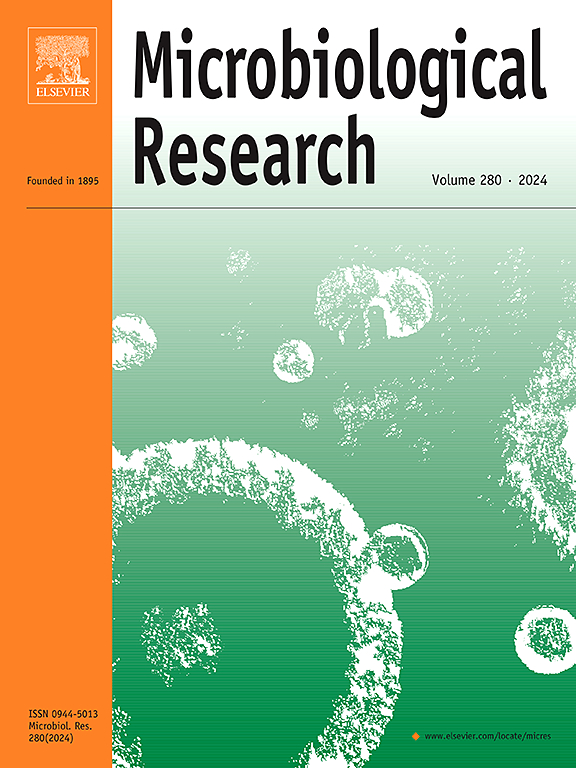Effect of pathogen Globisporangium ultimum on plant growth and colonizing bacterial communities
IF 6.9
1区 生物学
Q1 MICROBIOLOGY
引用次数: 0
Abstract
Plants recruit plant-associated microbes from soil to enhance their growth and mitigate the adverse effects of pathogen invasion on plant health. How pathogens impact the interactions of the plant-associated microbes and plant growth is poorly understood. We established S-microsystems (sterile soil inoculated with 101 bacteria isolated from humus soil with Artemisia annua, Oryza sativa or Houttuynia cordata), and N-microsystems (natural soil with these plants) to evaluate the effects of the fungus Globisporangium ultimum on plant growth and their colonizing bacterial communities (CBCs). S-microsystems and N-microsystems were inoculated with and without G. ultimum, respectively. Their seedling growth and CBCs were investigated. Plant height and root numbers in A. annua, O. sativa and H. cordata S-microsystems with G. ultimum were 34.5 % and 52.8 %, 23.1 % and 31.3 %, 102.1 % and 45.0 % higher than those without G. ultimum, respectively. The CBCs were diverse among S-microsystems of A. annua, O. sativa and H. cordata, and the CBC abundances in the three S-microsystems without G. ultimum were higher than those with G. ultimum. The relative abundances of bacterial genera Rhizobium, Pseudomonas, Brevundimonas and Cupriavidus were significantly positively related to plant growth. We determined that the CBCs in A. annua, O. sativa and H. cordata were selective and related to the plant species, and can mitigate disadvantageous influences of G. ultimum on seedling growth. The plants and their CBCs’ abundance and composition were differentially affected by G. ultimum. Our results provide evidence that CBCs promote plant growth due to dynamic changes in the composition and abundance of CBC members, which were affected by plant species and biotic factors.
病原体 Globisporangium ultimum 对植物生长和定植细菌群落的影响。
植物从土壤中吸收植物相关微生物,以促进其生长,减轻病原体入侵对植物健康的不利影响。病原体如何影响植物相关微生物与植物生长之间的相互作用,人们对此知之甚少。我们建立了 S-微系统(无菌土壤,接种 101 个从含有黄花蒿、桔梗或蕺菜的腐殖质土壤中分离的细菌)和 N-微系统(含有这些植物的天然土壤),以评估真菌 Globisporangium ultimum 对植物生长及其定植细菌群落(CBC)的影响。在 S-微系统和 N-微系统中分别接种和不接种球孢伞菌。对它们的幼苗生长和 CBC 进行了调查。与未接种超微革兰氏菌的 S-微系统相比,接种了超微革兰氏菌的 A. annua、O. sativa 和 H. cordata 的 S-微系统的株高和根数分别增加了 34.5 % 和 52.8 %、23.1 % 和 31.3 %、102.1 % 和 45.0 %。A.annua、O.sativa和H.cordata的S-微系统中的CBC种类繁多,没有G. ultimum的三个S-微系统中的CBC丰度高于有G. ultimum的三个S-微系统。根瘤菌属、假单胞菌属、芽孢杆菌属和铜绿微囊藻属细菌的相对丰度与植物生长呈显著正相关。我们确定,A. annua、O. sativa 和 H. cordata 的 CBCs 具有选择性,与植物种类有关,可以减轻 G. ultimum 对幼苗生长的不利影响。植物及其 CBCs 的丰度和组成受到 G. ultimum 的不同影响。我们的研究结果提供了证据,证明CBC促进植物生长是由于CBC成员的组成和丰度受植物物种和生物因素的影响而发生动态变化。
本文章由计算机程序翻译,如有差异,请以英文原文为准。
求助全文
约1分钟内获得全文
求助全文
来源期刊

Microbiological research
生物-微生物学
CiteScore
10.90
自引率
6.00%
发文量
249
审稿时长
29 days
期刊介绍:
Microbiological Research is devoted to publishing reports on prokaryotic and eukaryotic microorganisms such as yeasts, fungi, bacteria, archaea, and protozoa. Research on interactions between pathogenic microorganisms and their environment or hosts are also covered.
 求助内容:
求助内容: 应助结果提醒方式:
应助结果提醒方式:


